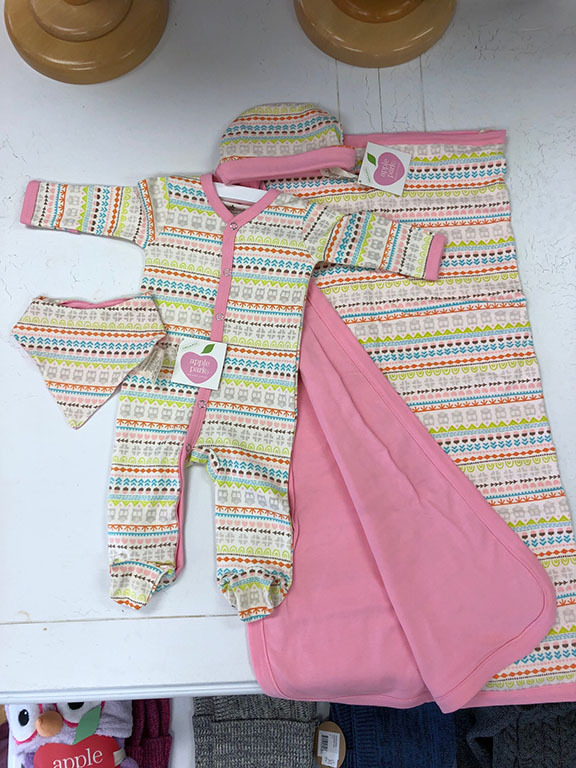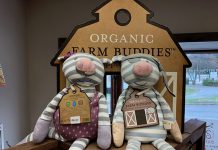Plush Organic Farm Buddies, by Apple Park, are made with eco-friendly materials.
Photo by Judy O’Gorman Alvarez
By Cassie Galasetti
Did you know the apparel industry is the second largest polluter in the world, after the oil industry? Every year more than 90 billion articles of clothing are made worldwide, creating toxins and pesticide waste affecting the Earth.
Only an estimated 1 percent of materials used to make clothing is recycled. That creates an overwhelming loss of $100 billion of materials every year. Furthermore, Americans throw out about 80 pounds of clothing per year.
It’s not all bad news, though. Knowing these statistics, many fashion brands are making it their mission to produce clothing that has less of an environmental impact, calling it “sustainable fashion.”
Sustainable fashion has no set definition, but embraces practices that reduce the environmental impact of how clothes are manufactured and marketed, including what dyes are used, how water waste is handled, use of recycled materials, transporting and storing the clothing, sales, and even the working conditions in factories where clothes are made.
Companies establishing sustainable fashion practices promote clothing that is “biodegradable,” “eco-friendly,” “organic,” or labeled “fair trade.”
The biodegradability of fabrics is mostly determined by the amount of chemicals used in the textile lifecycle. Normally the more chemicals used to produce an article of clothing, the longer it takes to biodegrade. For instance, silk is one of the most resilient fibers, becoming tougher over time; it starts to show signs of biodegradation around the four-year mark. A fabric like cotton takes as little as one to five months to completely biodegrade.
Eco-friendly clothes have been manufactured with minimal or no harm to the environment. Unfortunately, there is no such thing as a 100 percent eco-friendly piece of clothing, but those made from hemp and organic cotton come pretty close. Hemp is a plant material that uses very little water, thereby reducing the environmental impact. Organic, vegetable-based dyes also qualify as eco-friendly.

Photo by Judy O’Gorman Alvarez
Brands like Rothy’s produce shoes using recycled plastic, thus keeping it out of landfills.
Fair Trade fashion describes a product or brand that has been certified and labeled by an organization as meeting a set of required standards. These standards are designed to support makers from underdeveloped countries through trading, workers’ rights, protection of the environment and the marketing of sustainability. Time and again the Patagonia brand has been praised for its sustainable fashion; the brand offers a “Fair Trade Collection” online and in stores and also produces items out of recycled materials.
Organic clothing is described as clothing from materials raised in or grown in agreement with organic agricultural standards. For example, the land where the raw materials grew must be pesticide and fertilizer free.
Now that you know some ways fashion can help instead of harm the environment, how do you know if the clothing you’re buying is sustainable?
A number of popular clothing brands are proud of their commitment to sustainable fashion and clearly tout it on their clothing and in advertising.
Like a USDA organic label on a food product, brands are starting to us environmental certifications on clothing labels, though there isn’t a one- size-fits-all label.
When you’re out shopping, be on the lookout for a Fair Trade certification label on clothing and pay attention to the fabric content and where the garment was made. Fabrics such as hemp, organic cotton, linen, wool, bamboo, silk and soy are more sustainable than other fabrics and better for the environment.
Fabrics made of polyester or nylon are chemically derived and therefore less eco-friendly than others.
Look for companies which are certified B Corporations, businesses that work to build a sustainable balance between making a profit and protecting the planet. These companies meet the highest social and environmental standards.
Apps like Good On You can also help you track a company’s environmental impact. And shopping at local consignment shops and vintage stores makes you a participant in the recycling process. Many stores will also give you discounts for donating your used clothing rather than tossing it in the trash.
The more consumers know about the products and companies they purchase their clothing from, the more it will help make a big dif ference in the over-all environmental impact on our world.














